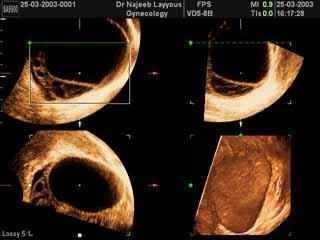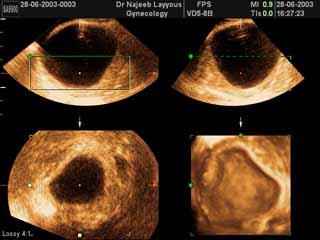Ovarian cysts Definition, Types, Signs and symptoms, Causes of Ovarian Cysts, Complications, Diagnoses, prevention and Treatment options
Definition of Ovarian Cyst
- It is a fluid filled sac, within or outside of the ovary.
- The ovaries are two small organs located on either side of the uterus. They produce hormones such as, estrogen which facilitates menstruation.
- Every month, the ovary is programmed to produce an egg, which is important for fertilization.
- Any follicle larger than 2 cm in diameter is called an ovarian cyst, which may vary in size from small to very large.
- The majority of cysts are benign and harmless.
- It can occur at any age, but mostly during child bearing age.
- They may be:
1- Functional cyst (most common type), and they are short lived.
2- Pathological cyst, which may be harmless (benign) or malignant (cancerous).
Signs and symptoms of Ovarian Cyst
- Symptoms:
The patient feels pain.
- Signs:
The doctor must investigate and detect the cause.
- In most cases of ovarian cyst, they will be small and benign with no symptoms or signs.
- There are also other conditions that may have the same symptoms and signs of ovarian cyst like: pelvic inflammatory disease, ectopic pregnancy, ovarian cancer, appendicitis and diverticulitis.
- These signs and symptoms are:
1- Irregular menstruation.
2- Pelvic pain either persistent or intermittent before menstruation begins or before it ends.
3- Pain during sex.
4- Pain during defecation.
5- Pressure on the bowel and bladder.
6- Pregnancy symptoms such as breast tenderness or nausea.
7- Bloating and swelling.
8- Problems during emptying your bladder.
9- Loss of appetite.
10- Hormonal abnormalities which may result in changes in the breasts and body hair growth.
Symptoms that need immediate medical attention:
1- Sudden, severe abdominal pelvic pain, this may be due to torsion (the cyst is twisted on its pedicle and may be cutting the blood supply), or due to rupturing of the cyst.
2- Pain accompanied by fever and vomiting.
3- Cancer.
Causes of Ovarian Cysts:
Functional ovarian cysts:
Two types:
1- Follicular cyst:
This is the most common type of ovarian cyst. Usually every month, the ovary will produce one egg which is formed in a follicle that contains fluid to protect the growing egg. Then, each month the follicle will burst and the egg is released into the tube, down to the uterus, in order to be fertilized. When the follicle does not shed the egg, it will accumulate fluid, and form a follicular cyst, which will evacuate on its own, without treatment.
2- Luteal ovarian cyst:
When the egg is released, the tissue that is left behind is the corpus luteum, which will shrink over time, but if it accumulates blood, it will form hemorrhagic cuprous luteal cyst, that most of the time disappears on its own, over few months. However, sometimes it may rupture and cause severe pain or bleeding.
Pathological cysts:
1- Dermoid cyst (cystic teratoma):
The most common pathological cyst in females under the age of 30, it is usually benign, arising from totipotent germ cell, these cysts contain teeth, hair, skin, bone and all other tissues, and need to be removed, surgically.
2- Cystadenomas:
These cysts are formed from the outer layer of the ovary. They are filled either with thick mucus or a watery liquid.
- They may grow inside the ovary or they may be attached to the ovary on a stalk.
- They are rarely cancerous, but they need to be removed surgically.
3- Endometriosis:
These affect patients with endometriosis, where the lining of the endometrium grows outside of the uterus. In this case. the ovary also needs surgical removal.
4- Polycystic ovary syndrome:
These are small, harmless cysts caused by a hormonal imbalance, those patients are at a higher risk to develop ovarian cysts.
Complications of Ovarian Cysts:
- Many cysts are asymptomatic and are discovered incidentally.
- Cysts that develop after menopause may be cancerous.
- Some cyst may:
Rupture:
Causes severe pain and may lead to bleeding.
Get twisted:
If the ovary is enlarged, it will move from its place and become twisted over its pedicle, cutting the blood supply and causing severe pain.
What causes ovarian tumors?
- If the tumor is non cancerous, it is benign. If it is cancerous, it is malignant and must be addressed.
- Types of ovarian tumors:
1- Epithelial cell tumors which arise from the epithelium of the ovary. They are the most common ovarian tumor.
2- Germ cell tumors are mostly benign and arise from the cells that produce the oocyte.
3- Stromal tumors arise from the cells that produce ovarian hormones.
Risk factors for cancer:
1- Age, especially after menopause.
2- Smoking.
3- Obesity.
4- Induction of ovulation drugs.
5- Hormone replacement therapy.
6- Nullipara or a female who has never breastfed.
7- Positive family history of ovarian, colorectal, breast cancer (those who have the BRCA gene).
Oral contraceptives may reduce the risk of ovarian cancer.
Diagnoses of Ovarian Cysts
- If an ovarian cyst is suspected, your doctor may need to do further testing to determine its type and the appropriate treatment:
1- Pregnancy test:
A positive pregnancy test means that your cyst is a corpus Luteum cyst.
2- Pelvic ultrasound:
It is a pain free procedure where a probe is introduced vaginally, and by this we can evaluate the uterus and both ovaries, so we can determine the size and consistency of any cyst, either fluid - containing cyst( mostly benign), cyst containing solid material, or mixed materials, which need further evaluation to rule out cancer.
3- Laparoscopy:
It is a thin telescope inserted through your abdomen, and using it, we can visualize the uterus, both ovaries and tubes, and if a cyst is present, the doctor can remove it laparoscopically.
4- Ca125:
This protein is increased in cases of ovarian cancer, but there are several benign conditions that may elevate this protein, such as, endometriosis, uterine fibroid, and pelvic inflammatory disease.
5- Computed tomography, magnetic resonance imaging and positron emission tomography will be ordered in cases of cancer, to determine the extent of spread of the tumors.
Treatment of Ovarian Cysts
Mode of treatment depends on several factors:
1- The age of the patient.
2- If the patient is pre or post menopause.
3- Cyst appearance.
4- Cyst size.
5- Symptoms caused by the cyst.
A- Observation:
1- Most of the cysts disappear on their own, over 8-12 weeks, especially if the patient is premenopausal, and if the cyst is functionally 2 - 5cm in diameter.
2- Follow up is recommended after 1 month.
3- In post-menopausal women, monitoring with ultrasound is recommended in addition to checking your Ca125 level. If there is a change in the size or texture, they need immediate intervention. After the cyst has disappeared, the patient needs to undergo a follow up scan, 4 months later.
4- During this time, avoid drinking a lot of caffeine or alcohol and drink a lot of water in order to decrease symptoms.
B- Birth control pills:
These drugs do not decrease the cyst size, but they do prevent formation of new cysts in patients with frequent cyst forming.
C- Surgery for Ovarian Cysts:
Is indicated under the following conditions:
1- Complex ovarian cysts that persist over months.
2- Persistent symptomatic cysts over 2 - 3 menstrual cycles.
3- Simple ovarian cysts larger than 5 - 10cm.
4- Cysts in perimenopause or postmenopausal female.
5- If the cyst is suspicious or may be cancerous.
There are 2 types of surgery:
Laparoscopy:
- Where 2 - 3 small cuts in the abdominal skin are done, and a telescope is introduced through one of the ports and the cyst is removed, and sent for histopathology.
- This method has a faster recovery rate and will not affect the woman's fertility.
Laparotomy:
- Is done if the cyst is cancerous. A cut through the top of pubic hair line is done and the cyst is removed. The doctor may need to remove the other ovary, and the uterus and adjacent organs, if the tumor is extended.
- If it is cancerous, you may need additional intervention, according to the extent and type of tumor
1- Chemotherapy:
Medications that are given intravenously, orally or directly into the abdomen in order to kill cancer cells, but they also kill normal cells. They may cause nausea, vomiting, hair loss, kidney damage and predispose to infection.
2- Radiotherapy:
Is the use of high energy x-rays that kill cancer cells. It is delivered either externally or placed inside the body near the cancer. It also has side effects such as, skin redness, nausea, diarrhea and fatigue.
Prevention of Ovarian Cysts
- There is no medication to prevent cyst formation but regular follow up helps in preventing complications from the cyst.
- Oral contraceptives may prevent follicular cyst formation (only this type of cyst).

Ovarian Cyst

Ovarian Cyst
Dr Najeeb Layyous F.R.C.O.G
Consultant Obstetrician, Gynecologist and Infertility Specialist







 Pregnancy Due Date Calculator
Pregnancy Due Date Calculator
 Chinese Gender Predictor
Chinese Gender Predictor
 Ovulation Calculator
Ovulation Calculator
 IVF Due Date Calculator
IVF Due Date Calculator
